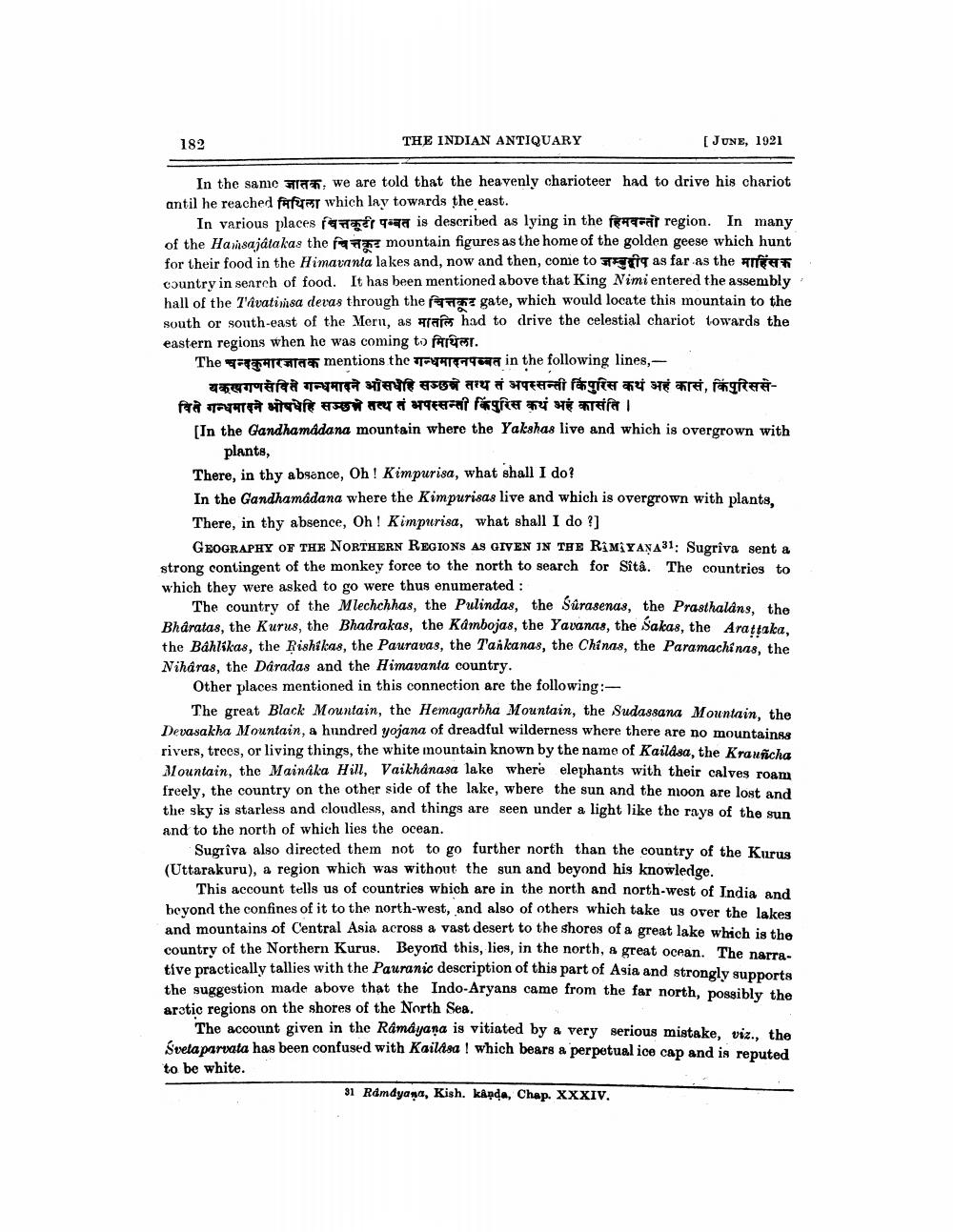________________
182
THE INDIAN ANTIQUARY
[JUNE, 1921
In the same , we are told that the heavenly charioteer had to drive his chariot antil he reached fofuras which lay towards the east.
In various places f or is described as lying in the f air region. In many of the Harnsajátakas the mountain figures as the home of the golden geese which hunt for their food in the Himarrinta lakes and, now and then, come to go as far as the wife country in senrch of food. It has been mentioned above that King Nimi entered the assembly hall of the T'avatinsa deras through the gate, which would locate this mountain to the south or south-east of the Meru, as arars had to drive the celestial chariot towards the eastern regions when he was coming toमिथिला.
The चन्दकुमारजातक mentions the गन्धमादनपब्बत in the following lines,
यकखगणसेविते गन्धमादने ओसधेहि सञ्छन्ने तग्य तं अपस्सन्ती किंपुरिस कथं अहं कासं, किंपुरिससेविते गन्धमादने भोषधेहि सञ्छने तत्थतं अपस्सन्सी किंपुरिस कथं भहं कासंति । In the Gandhamadana mountain where the Yakshas live and which is overgrown with
plants, There, in thy absence, Oh! Kimpurisa, what shall I do? In the Gandhamádana where the Kimpurisas live and which is overgrown with plants, There, in thy absence, Oh ! Kimpurisa, what shall I do?]
GEOGRAPHY OF THE NORTHERN REGIONS AS GIVEN IN THE RÎM YAŞA31: Sugriva sent a strong contingent of the monkey force to the north to search for Sita. The countries to which they were asked to go were thus enumerated :
The country of the Mlechchhas, the Pulindas, the Súrasenas, the Prasthalans, the Bharatas, the Kurus, the Bhadrakas, the Kambojas, the Yavanas, the Sakas, the Arattaka. the Bahiskas, the Rishikas, the Pauravas, the Tankanas, the Chinas, the Paramachinas, the Niháras, the Daradas and the Himavanta country.
Other places mentioned in this connection are the following: -
The great Black Mountain, the Hemagarbha Mountain, the Sudassana Mountain, the Devasakha Mountain, a hundred yojana of dreadful wilderness where there are no mountainss rivers, trees, or living things, the white mountain known by the name of Kaildsa, the Krauñcha Mountain, the Mainaka Hill, Vaikhanasa lake where elephants with their calves roam freely, the country on the other side of the lake, wbere the sun and the moon are lost and the sky is starless and cloudless, and things are seen under a light like the rays of the sun and to the north of which lies the ocean.
Sugriva also directed them not to go further north than the country of the Kurus (Uttarakuru), a region which was without the sun and beyond his knowledge.
This account tells us of countries which are in the north and north-west of India and beyond the confines of it to the north-west, and also of others which take us over the lakes and mountains of Central Asia across a vast desert to the shores of a great lake which is the country of the Northern Kurus. Beyond this, lies, in the north, a great ocean. The narra. tive practically tallies with the Pauranic description of this part of Asia and strongly supports the suggestion made above that the Indo-Aryans came from the far north, possibly the aratio regions on the shores of the North Sea.
The account given in the Ramayana is vitiated by a very serious mistake, viz., the Svela parvata has been confused with Kailasa! which bears a perpetual ice cap and is reputed to be white.
31 Rdmdyana, Kish. kanda, Chap. XXXIV.




